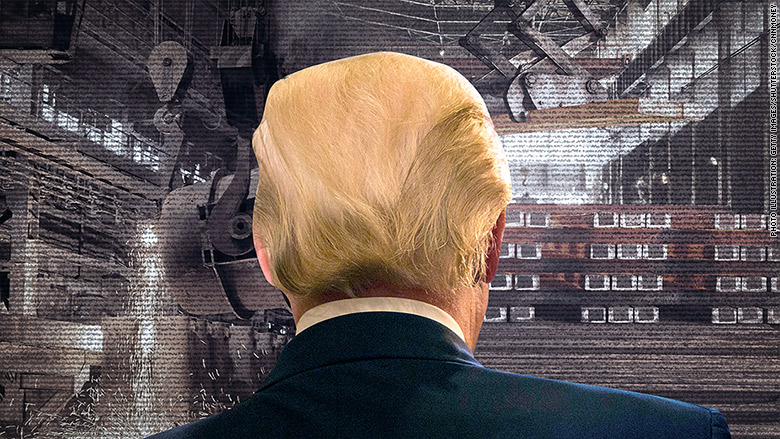Assessing The Impact Of Trump's Tariffs On US Manufacturing

Table of Contents
Intended Goals of the Tariffs
The Trump administration's tariff policy on US manufacturing aimed to achieve two primary objectives: protecting domestic industries and leveraging tariffs as a bargaining chip in international trade negotiations.
Protecting Domestic Industries
The primary goal was to safeguard American manufacturing jobs and revitalize struggling sectors by reducing foreign competition and boosting domestic production. This was particularly evident in the steel and aluminum industries.
- Increased demand for domestically produced steel and aluminum: The tariffs made imported steel and aluminum more expensive, theoretically increasing demand for US-produced materials.
- Support for struggling US steel and aluminum mills: The increased domestic demand was intended to provide a lifeline to domestic steel and aluminum mills, many of which had been struggling with competition from cheaper imports.
- Potential for new job creation in these sectors: Increased production levels were expected to lead to new job creation in the steel and aluminum sectors. However, the actual impact was more nuanced, as we will explore later.
Reciprocation and Trade Negotiations
Tariffs were also strategically employed as leverage in trade negotiations with other countries, aiming to secure more favorable trade agreements.
- Pressuring other nations to reduce their own trade barriers: The US sought to pressure trading partners to lower their tariffs and other trade barriers on US goods.
- Seeking improved market access for US goods: Tariffs were a tool to negotiate better market access for American goods in foreign markets.
- Reducing the US trade deficit: By reducing imports and boosting exports, the administration aimed to shrink the US trade deficit. The success of this strategy is debatable, given the complexities of international trade.
Actual Economic Impacts of the Tariffs
While the intended goals were clear, the actual economic impacts of Trump's tariffs on US manufacturing were far more complex and less straightforward.
Impact on Manufacturing Employment
Did the tariffs lead to a significant increase in manufacturing jobs? The reality was far from a simple "yes" or "no."
- Job creation in some sectors (e.g., steel): Some sectors, like steel production, experienced a temporary uptick in employment due to increased domestic demand.
- Job losses in other sectors due to higher input costs: However, many other manufacturing sectors experienced job losses due to the increased cost of imported steel and aluminum, which are vital inputs in countless products.
- Impact on smaller businesses and their supply chains: Smaller businesses, lacking the resources of larger corporations, were disproportionately affected by the increased costs and supply chain disruptions.
Effects on Prices and Inflation
The tariffs had a noticeable impact on consumer prices and the overall inflation rate.
- Increased prices for goods containing steel and aluminum: The higher cost of steel and aluminum translated into higher prices for numerous consumer goods, from automobiles to appliances.
- Impact on consumer spending and economic growth: Increased prices reduced consumer purchasing power, potentially hindering economic growth.
- The role of inflation in influencing consumer and business behavior: Inflation, driven in part by the tariffs, influenced consumer and business decisions, leading to reduced investment and spending in some sectors.
Supply Chain Disruptions
The tariffs significantly disrupted global supply chains, impacting US businesses heavily reliant on imported components.
- Increased costs for businesses relying on imported materials: Companies depending on imported materials faced significantly higher costs, reducing profitability and competitiveness.
- Shifting of production to other countries: Some businesses shifted production to other countries to avoid the tariffs, resulting in job losses in the US.
- Increased complexity and uncertainty for businesses: The tariffs introduced significant uncertainty and complexity into business planning, making it more challenging to manage supply chains and predict future costs.
Long-Term Consequences and Unintended Outcomes
The long-term consequences of the Trump administration’s tariffs extended beyond the immediate economic impacts, creating ripples across global trade relations.
Retaliatory Tariffs and Trade Wars
The tariffs sparked retaliatory tariffs from other countries, escalating into a trade war that had detrimental consequences.
- Damage to US exports: Retaliatory tariffs damaged US exports, hurting various sectors dependent on international trade.
- Negative impacts on international trade relations: The trade war significantly strained international trade relations, eroding trust and cooperation between trading partners.
- Economic uncertainty and reduced investment: The uncertainty created by the trade war discouraged investment and economic growth, both domestically and globally.
Impact on Global Trade Relations
The long-term effects on international trade relationships and cooperation remain significant concerns.
- Erosion of trust between trading partners: The trade war eroded trust and cooperation among trading partners, making future collaborations more difficult.
- Challenges to multilateral trade agreements: The protectionist policies undermined multilateral trade agreements, raising questions about the future of global trade governance.
- Increased protectionist sentiment globally: The trade war fueled protectionist sentiment globally, leading to increased trade barriers and harming international economic cooperation.
Conclusion
The Trump administration's tariffs on US manufacturing had a complex and multifaceted impact. While some sectors experienced short-term gains, the overall economic consequences were mixed, with increased prices, supply chain disruptions, and retaliatory tariffs offsetting potential benefits in job creation. The long-term effects on global trade relations and the US economy are still unfolding and require further analysis. The effects of these tariffs serve as a case study in the complexities of trade policy and its unintended consequences.
Call to Action: Understanding the full impact of Trump's tariffs on US manufacturing requires ongoing research and critical analysis. By exploring the complexities of international trade and its impact on various industries, we can better inform future trade policy discussions and develop strategies to strengthen the US manufacturing sector effectively. Continue researching the effects of Trump’s tariffs to form your own informed opinion on their overall impact on US manufacturing.

Featured Posts
-
 Executive Office365 Accounts Compromised Millions Stolen In Cybertheft
May 06, 2025
Executive Office365 Accounts Compromised Millions Stolen In Cybertheft
May 06, 2025 -
 The Impact Of The La Palisades Fires A List Of Celebrity Home Losses
May 06, 2025
The Impact Of The La Palisades Fires A List Of Celebrity Home Losses
May 06, 2025 -
 Gigi Hadid And Bradley Cooper Instagram Official At Her 30th Birthday Party
May 06, 2025
Gigi Hadid And Bradley Cooper Instagram Official At Her 30th Birthday Party
May 06, 2025 -
 Mindy Kalings Hollywood Walk Of Fame Star A Peplum Celebration
May 06, 2025
Mindy Kalings Hollywood Walk Of Fame Star A Peplum Celebration
May 06, 2025 -
 Newark Airport Staffing Shortage Causes Impacts And Potential Solutions
May 06, 2025
Newark Airport Staffing Shortage Causes Impacts And Potential Solutions
May 06, 2025
Latest Posts
-
 Halle Bailey The Target Of Ddgs New Song Dont Take My Son
May 06, 2025
Halle Bailey The Target Of Ddgs New Song Dont Take My Son
May 06, 2025 -
 Ddgs Take My Son Sparks Debate Is Halle Bailey The Target
May 06, 2025
Ddgs Take My Son Sparks Debate Is Halle Bailey The Target
May 06, 2025 -
 Analysis Of Ddgs Dont Take My Son Diss Track Aimed At Halle Bailey
May 06, 2025
Analysis Of Ddgs Dont Take My Son Diss Track Aimed At Halle Bailey
May 06, 2025 -
 Ddgs New Diss Track Take My Son Aimed At Halle Bailey
May 06, 2025
Ddgs New Diss Track Take My Son Aimed At Halle Bailey
May 06, 2025 -
 Duze Zamowienie Trotylu Polska Na Swiatowym Rynku Materialow Wybuchowych
May 06, 2025
Duze Zamowienie Trotylu Polska Na Swiatowym Rynku Materialow Wybuchowych
May 06, 2025
